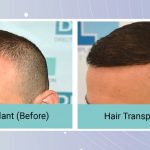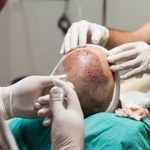Hair Transplantation for Hairline Correction
Hair transplantation is the only cosmetic surgical treatment for a receding hairline. To rebuild natural hair direction and angulation and restore hair density, healthy hair follicles are taken from the substantial donor area, the back of the scalp, and placed into the hairline during the process. The DHITM hair transplant treatment is non-invasive and usually performed under local anesthesia.
Hair Anatomy
Hair is a fibrous structure that grows from the skin. It primarily comprises keratin, a tough protein that gives hair strength and flexibility. Hair follicles are the tiny pockets in the skin where hair begins to form. These follicles are like miniature factories, producing keratin cells that gradually harden and become the hair shaft we see on our heads and bodies.
To better understand hair, let’s break down its key components:
- Hair Shaft: This is the part of the hair we can see—the visible part that extends above the skin’s surface. It’s made of keratin, a vital protein.
- Hair Follicle: This is the tiny pocket in the skin where the hair grows from. It’s like a miniature factory that produces the keratin cells that form the hair shaft.
- Follicular Unit: Hair doesn’t grow individually; it’s grouped in units. These units can contain one, two, three, four, or more hairs.
- Hair Graft: A “graft” refers to a single follicular unit in hair transplantation. It’s the basic unit transplanted from one area of the scalp to another. Think of it as a tiny bundle of hair that’s moved to a new location.
Hair’s Structure:
Imagine hair as a cable made up of three separate strands. The outermost layer is called the cuticle. It’s a tough, protective layer made of highly keratinized cells. Beneath the cuticle is the cortex, which forms the bulk of the hair shaft and gives it its strength and color. Finally, at the very center, some hairs have a medulla. This small, soft core is often absent in fine hair.
Hair Growth:
These layers are created by special cells called matrix cells. These cells are in a bulb region at the hair follicle’s base. As these cells divide and produce keratin, they push the older cells upward, forming the hair shaft.
Internal Root Sheath: Made up of keratinized hair matrix cells, the internal root sheath surrounds the hair and extends towards the base of the hair follicle. This form of keratin is similar to the surface keratin of the skin and is softer than that of the hair. This layer of cells breaks down when the sebaceous gland’s ducts enter the follicle. Sebum is released onto the hair via the sebaceous glands’ channels.
Third Root Sheath: The external root sheath encircles the internal root sheath. This is an epidermal tubular invagination that is not involved in the growth of hair. A glassy foundation membrane isolates it from the surrounding connective tissue.
The hair follicle is connected to a little bundle of smooth muscle cells known as the arrector pili muscle. Contraction of this muscle raises the hair, gives you goosebumps, generates heat, and facilitates the discharge of sebum from the gland into the duct.
The dermal papilla, located at the base of the hair follicle or hair bulb, houses the hair’s blood supply. A basement membrane divides the dermal papilla from the hair matrix, which is located slightly above it and includes the internal root sheath and the proliferating cells that produce hair. The hair matrix cells multiply and ascend, progressively turning keratinized to form the hair, much like the basal layer of the epidermis.
Here is further information on hair transplantation to correct hairlines:
- Grafts: Grafts can be classified as “mini” or “micro” (follicular clusters). Individual hair follicles in micro grafts range from one to three, whereas follicular groupings have four to six hairs each. One to three grafts per hairline generate a natural-looking transition zone from the forehead to thicker hair. In contrast, micro/mini grafts produce fine hair that closely mimics natural hair development.
- Method: After the grafts are ready, the surgeon uses a scalpel or needle to make holes or slits in the skin, cleans and numbs the region before inserting each transplant into one of the holes. The transplant procedure might take four to eight hours, depending on its size.
- Cost: The cost of hair transplant treatment can vary significantly based on several factors, including the extent of hair loss, the specific technique used, and individual goals. We’d love to invite you for a personalized consultation at DHI’s clinic to provide the most accurate estimate.
During the consultation, our specialists will assess your unique situation, discuss your expectations, and develop a tailored treatment plan that suits your needs. This one-on-one session also allows you to learn more about the procedure, ask questions, and understand the value you’ll receive with our expertise and care. A face-to-face discussion is the best way to ensure you receive the precise information and guidance you need for your hair restoration journey.
We look forward to helping you achieve the results you desire!
What is the DHITM Hair Transplant Procedure?
DIRECT HAIR IMPLANTATION (DHITM) – DHITM is a unique hair transplant procedure that can only be performed by:
- DHITM Technique
- DHITM certified doctors
- DHITM protocols
- DHI’s patented instruments
- At DHITM authorized clinics
No pain, no scars, no downtime. The perfect natural result every single time.
What age range is ideal for hairline transplantation?
The males should get hair transplants between 24 and 60. By that time, you’ll be more aware of your hair loss pattern and be able to determine if finasteride and minoxidil alone can stabilize your hair loss or whether a hair transplant is indeed necessary.
Do transplanted hairlines look natural?
Yes, transplanted hairlines can look very natural with the DHI (Direct Hair Implantation) procedure.
DHI is a minimally invasive technique that involves directly implanting hair follicles into the recipient area using a unique DHI Implanter tool.
This method allows for precise placement of the follicles, which is crucial for achieving a natural appearance.
Who is not an ideal candidate for a hair transplant?
In contrast, a person with a poor density of hair follicles is unlikely to benefit much from a hair transplant. To transplant donor follicles throughout the scalp, having a moderate-to-high hair density would be best. Plus, if a patient does not have a suitable donor for a hair transplant procedure or is entirely bald.
Can a Hair Transplant Procedure Cover a Completely Bald Scalp?
The good news is that if you have enough donor hair, you can still gain from a hair transplant, including the horseshoe-shaped ring of hair that often persists after balding.
7 Key questions you should ask before choosing your hair loss solution
1 Who will perform the procedure?
In most clinics, procedures are performed by technicians only. The clinic owners are plastic surgeons and dermatologists, mainly involved in sales and marketing. Their involvement in the actual procedure is minimal. It would help if you went to a clinic where a doctor performs the entire procedure himself/herself, not through a technician.
It is also important to check if the clinic/doctor specializes in hair transplants or offers other aesthetic treatments, such as Botox. A better choice would be to go for a super specialist doctor.
2 Is your doctor suitably trained and certified? Do they follow standard and accredited protocols?
Doctors often learn about hair transplants from other doctors without any evaluation or certification process. It can take years for them to understand the intricacies of hair transplants. Further, most doctors do not follow written protocols and perform procedures based on personal preferences, leading to sub-optimal results.
Please check if the doctor performing the procedure has training and accreditation from a reputed institute. Very importantly, personally verify if the clinic has written protocols for all stages of the hair transplant procedure, including detailed safety protocols.
3 What is the experience of the clinic/doctor you are going to?
Hair transplants are a relatively new area of practice, which has lured many doctors to leave their practice in the field of their expertise and move towards hair transplants only in the last 3-5 years. Many clinics may not have the experience, protocols, or necessary expertise to handle hair transplant cases. Please ensure that the clinic has been established for many years and has a verifiable reputation. Do not just rely on what they claim.
4 How does the clinic ensure the quality of your results?
Research shows that, on average, only half of the implanted hair may grow in certain clinics without proper experience. This is because the clinic may not have access to the latest techniques, instruments, tools, protocols, etc. Please avoid freelancers working in many clinics on a case-by-case basis. They will likely spoil your case as they may care least for the patient. Sometimes, the doctor may be very qualified or experienced but past his prime to be able to give good results.
Do check if the doctor’s work is supervised by someone. Does the doctor follow any certification, assessment, and quality monitoring process? It is not advised to go to a clinic where there is only one doctor whose work goes unsupervised.
Good results can only come with the right technique, instruments, tools, protocols, training, assessment, and quality control.
5 How do you ensure your safety during and after the hair transplant procedure?
Generally, hair transplants are safe and cannot lead to severe risks. However, sometimes scalp infections or even more severe conditions could occur if the correct safety protocols are not followed. This risk is very high when the procedure is performed by technicians or inexperienced doctors.
You are advised to ask relevant questions and follow the written safety protocols at the clinic.
Please see the procedure room and ask yourself if you feel confident about the safety protocols.
6 Would you go for a hair transplant without a proper evaluation of your alopecia?
The answer is obviously No. There are 10 kinds of alopecia. The correct treatment cannot be recommended unless a proper diagnosis is carried out. Many clinics recommend hair transplants without making a proper diagnosis. They also may not conduct a mathematical count of the donor and recipient areas to correctly assess the hair transplant requirement and feasibility. Please invest time and effort during your diagnosis and evaluate the doctor on proper dermatological examination diagnosis, precise donor and recipient area hair count, and computerized alopecia test. This results in a comprehensive lifetime treatment plan and the best results for your hair loss problem.
7 Should price play a role in choosing a hair transplant clinic or doctor?
Yes, of course, price is indeed an essential criterion. But you should not choose a clinic or doctor purely on the cost. Many doctors can reduce their costs significantly by reusing the instruments, compromising on safety standards, using technicians to do the procedures, etc. Quality and Safety come at a price. This is your investment in your safety and great-looking results for life. So, choose wisely.
With 75 locations across 45 countries, DHI Medical Group is the most extensive network of hair restoration clinics worldwide. DHI introduced the Direct Hair Implantation method in 2005, following its pioneering FUE in 2003. DHI is the gold standard in hair restoration thanks to its top-notch facilities, US and EU patents, and scientific advisory board. DHI keeps releasing novel therapies for different phases of hair loss. You are more than simply a patient at DHI; our medical staff consider your best interests when treating you. Thousands of treatments, including those of celebrities like movie stars, athletes, politicians, and business moguls, have been completed by DHI International.
Reasons for Hair Loss
One of the most prevalent issues globally is hair loss, which impacts approximately one-third of people on the planet. Many causes, including hormone imbalances, dandruff, infections on the scalp, stress, and hereditary susceptibility, can cause hair loss. While some of these variables may contribute to hair loss in many situations, hereditary pattern baldness is the most common cause, responsible for millions of women and approximately 95% of all hair loss in men.
The baldness pattern in men is inherited. Either the mother or the father can pass on the faulty gene. Hamilton made the groundbreaking discovery that androgens cause male pattern baldness. If the hair loss gene is inherited, male pattern baldness can occur even with an average level of androgens. Briefly, a specific level of androgens in the blood can cause male pattern baldness, also known as androgenic alopecia. The degree of hair loss varies and gets worse as people age.






